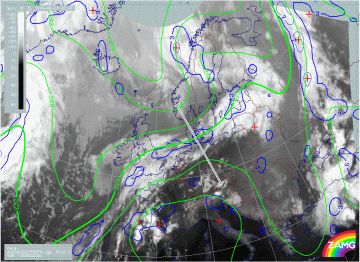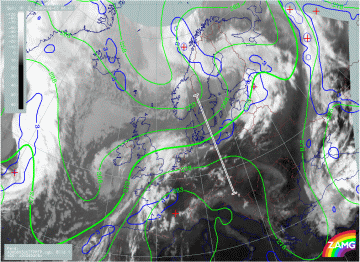Thermal Front Parameter and Equivalent Thickness
In addition to the parameters on isentropic surfaces the conceptual model "Front Decay" shows up very well in some parameters on isobaric surfaces. These partly rather basic parameters are available in forecast fields, and therefore be used operationally. The case study is in very good agreement with the basic findings.
Thermal Front Parameter and Equivalent Thickness
|
02 June 2000/18.00 UTC - Meteosat IR image; blue: thermal front parameter (TFP) 500/850 hPa, green: equivalent thickness 500/850 hPa,
position of vertical cross section indicated
|
03 June 2000/00.00 UTC - Meteosat IR image; blue: thermal front parameter (TFP) 500/850 hPa, green: equivalent thickness 500/850 hPa,
position of vertical cross section indicated
|
|
03 June 2000/06.00 UTC - Meteosat IR image; blue: thermal front parameter (TFP) 500/850 hPa, green: equivalent thickness 500/850 hPa,
position of vertical cross section indicated
|
|
In the 3 images above the dissipation of the frontal cloud band (FD) is clearly indicated by the equivalent thickness and the thermal front
parameter. At 02/18.00 UTC the gradient of isolines of the equivalent thickness, over the North Sea, to the rear of the cloud band, can be
clearly seen, and a continuos line of TFP accompanies the frontal cloud band, indicating a well developed baroclinic zone.
Although the lines of equivalent thickness show an even tighter gradient at 00.00 UTC, the thermal front parameter (TFP) is not as well
developed. At 06.00 UTC, the isolines of equivalent thickness still have a tight gradient but there is, no longer, any significant TFP over the
dissipation zone.


